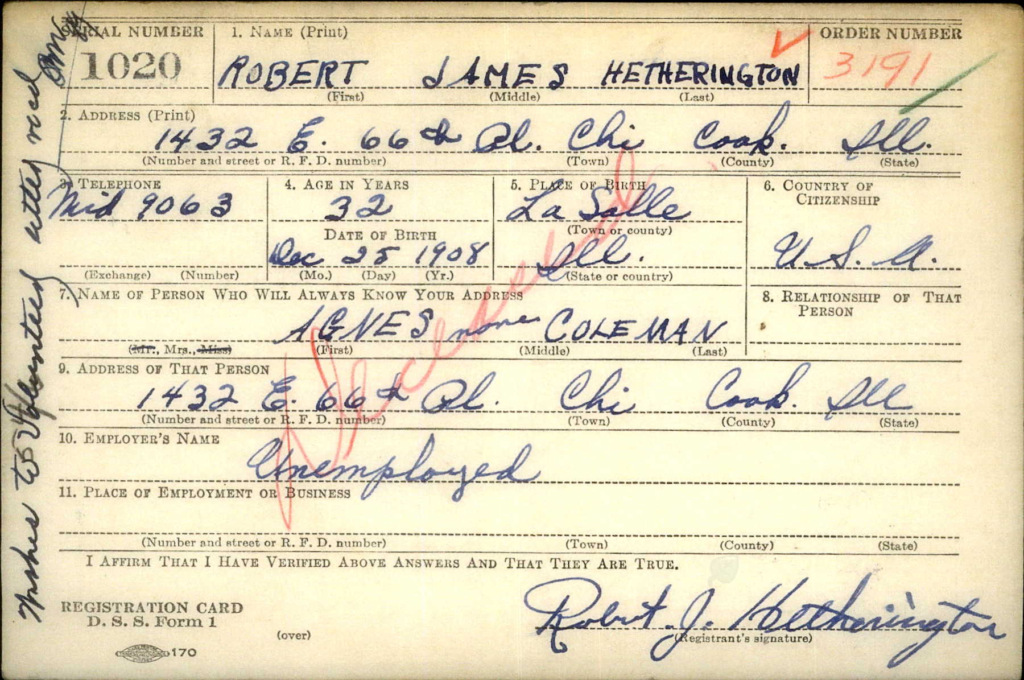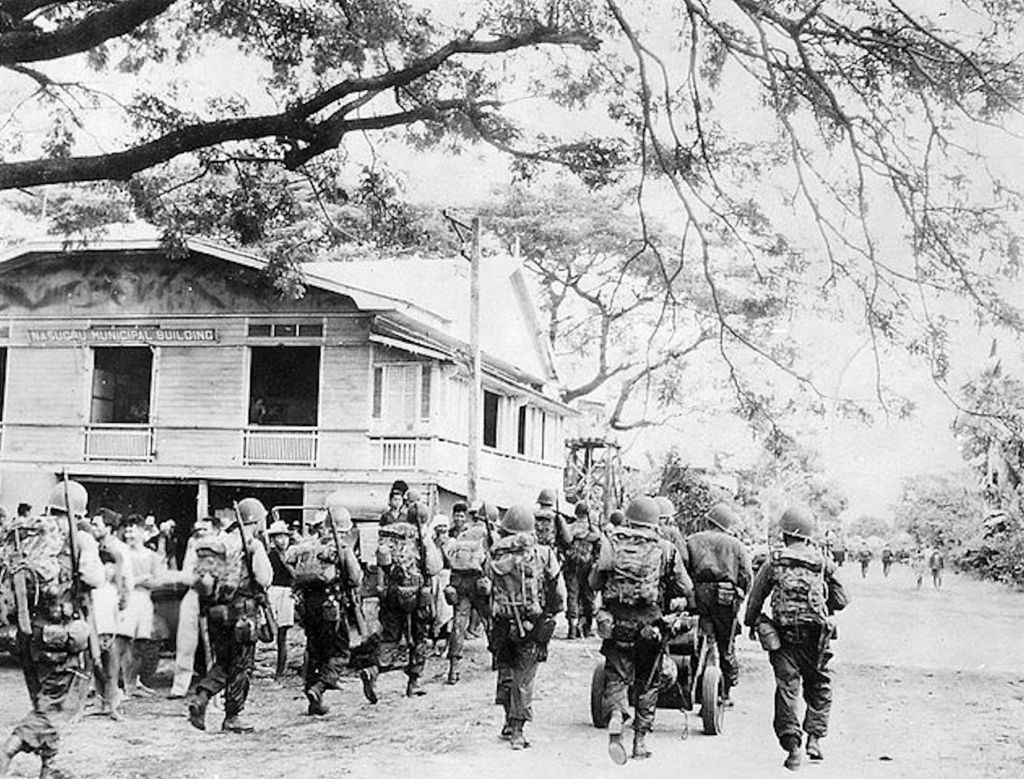Robert James Hetherington was born on either Christmas eve or Christmas day in 1908 in LaSalle, Illinois, to Thomas and Eleanor “Ella” Hanley Hetherington. His parents, both in their early to mid-twenties, married in October the year before his birth. His father, Thomas Hetherington, worked as a miner for the LaSalle County Carbon Coal Company in LaSalle. Robert’s grandfather, John Hetherington, worked at the same company as a supervisor. He had been there about 40 years and retired when Robert was about 16. However, the next year, in 1925, Robert’s grandfather died of a stroke. Soon after, Thomas, Robert’s father, left his job at the mine and eventually took up roofing instead.
Robert’s parents only had one other known child who did not survive so Robert grew up with no siblings. He did, however, have many aunts, uncles, and cousins. At least three of his uncles on his mom’s side served in World War I.
As Robert entered adulthood in the mid-1920s, he took a job as a clerk first at McLellan Stores and then at Bulfer Electric Company. By 1930 he was working for the Illinois Bell Telephone Company. And three years later he married a young widow, Mrs. Esther (Schaeffer) Massock.
By 1940 when he registered for the draft on October 16th, Robert was 32 years old, separated, and living in Chicago. He was one of several men from his ward who volunteered to enter the Army rather than wait to be drafted. He enlisted on 30 November 1940. At the time he was about five and a half feet tall and weighed about 160 pounds with blue eyes and gray hair.

Robert’s experience in the early years of his service is not known. In March 1943 training began at Camp Mackall for men assigned to the 188th Glider Infantry unit which was part of the 11th Airborne Division. Robert was part of this regiment in 1945 so perhaps he was assigned to this initial group when it was organized in 1943. The 188th held strict standards, focused on physical training, and ultimately “became an elite organization that had higher standards than a normal regiment, and thus better quality troops.” The gliders the troops operated were constructed of plywood and canvas and “held no promise of safe landings.”
After completing trainings at Camp Mackall, the regiment moved onto North Carolina and later to Camp Polk in Louisiana. By January 1944 they were preparing for overseas deployment. It was during this time that many in the 188th took advantage of parachute training. This led to the 188th becoming the Army’s first para-glider unit. In mid-April the division left for Camp Stoneman in California. Between “May 5 to May 18, 1944, the division embarked on different ships for the month’s journey to Oro Bay, New Guinea.”
Once in New Guinea, some men participated in the Australian New Guinea Administrations Unit’s jungle warfare school. Glider training took place from July through November 1944. By this time 75% of the enlisted men in the 11th Airborne were parachute qualified; however, it is not known if Robert took advantage of this training. Finally on 11 November 1944, the division sailed for Leyte in the Philippines. Once there they moved to relieve the 7th Division. Navigating the steep terrain in the area was challenging, particularly as the men had to do so through constant rain, mud, leeches, and exposure to malaria.
After battling the enemy throughout December, the division spent January 13th to the 26th preparing for the next operation. At the end of January 1945, they left for Luzon landing at Nasugbu. After arriving, they spent the next few weeks moving towards Manila. In late February they assisted in the rescue of 2,200 prisoners of war. On March 24th the 188th traveled to Alaminos. The region was similar in terrain to Leyte with gorges, thick jungle, no roads, and few trails. The engineers worked through April to build roads. While they worked, the 188th planned to drive south of Alaminos and occupy Center Ridge’s Hill 2480. After air strikes on April 30th the units made their move and found the enemy had abandoned the area. The 511th ended up capturing Center Ridge. And on May 2, 1945, the 188th moved to Lipa. However, in the operation to take Center Ridge, the 188th suffered 58 casualties—Robert J. Hetherington was one of those. He had been hit in the eye by an artillery shell fragments, taken to the hospital, and given a blood transfusion. But he did not survive his injuries.

Sergeant Robert James Hetherington was buried at Fort William McKinley Cemetery in the Philippines in Block D, Row 13, Grave 200. His Headstone Inscription and Interment Record notes he received the Purple Heart. For his service, he would have also received the Combat Infantryman Badge and the following medals: Army Good Conduct Medal, American Defense Service Medal, American Campaign Medal, Asiatic/Pacific Campaign Medal, and the World War II Victory.
This story is part of the Stories Behind the Stars project (see www.storiesbehindthestars.org). This is a national effort of volunteers to write the stories of all 421,000+ of the US WWII fallen saved on Together We Served and Fold3. Can you help write these stories? These stories will be accessible via smartphone app at any war memorial or cemetery.
If you noticed anything erroneous in this profile or have additional information to contribute to it, please email feedback@storiesbehindthestars.org.
SBTSProject/Illinois/LaSalle
SBTS Historian: Pam Broviak
You can also access this story at the following sites:
- Sources:
- 1910 U.S. Census, Thomas Hetherington, Ancestry.
- 1920 U.S. Census, Thomas Hetherington, Ancestry.
- 1930 U.S. Census, Thomas Hetherington, Ancestry.
- “Illinois Births and Christenings, 1824-1940,” Robert James Hetherington, 1907, FamilySearch
- “Illinois, County Marriages, 1810-1940,” Thomas F. Hetherington to Ella Hanley, 1907, FamilySearch
- “J. Hetherington Dies in LaSalle,” Spring Valley Gazette, 3 September 1925, p. 4, NewspaperArchive.
- U.S. City Directories, LaSalle, Illinois, 1926, Hetherington, p. 111, Ancestry.
- U.S. City Directories, LaSalle, Illinois, 1928, Hetherington, p. 142, Ancestry.
- “Former Spring Valley Resident Wed Saturday,” The DePue Leader, 24 February 1933, p. 8, NewspaperArchive.
- U.S., World War II Draft Cards Young Men, 1940-1947, Robert James Hetherington, Ancestry.
- U.S., World War II Draft Registration Cards, 1942, Thomas Francis Hetherington, Ancestry.
- “Draft Board 91 Lacks Volunteer for Army Call,” Southeast Economist, 21 November 1940, p. 1 and p. 7, NewspaperArchive.
- U.S., World War II Army Enlistment Records, 1938-1946, Robert J. Hetherington, Ancestry.
- The Small Change of Soldiering: The 188th Glider Infantry Regiment, 2d LT David W. Dengler, 1999.
- U.S., World War II Hospital Admission Card Files, 1942-1954, Robert J. Hetherington, Ancestry.
- U.S., Headstone and Interment Records for U.S., Military Cemeteries on Foreign Soil, 1942-1949, Robert J. Hetherington, Ancestry.
- https://www.findagrave.com/memorial/56770459/robert-j-hetherington